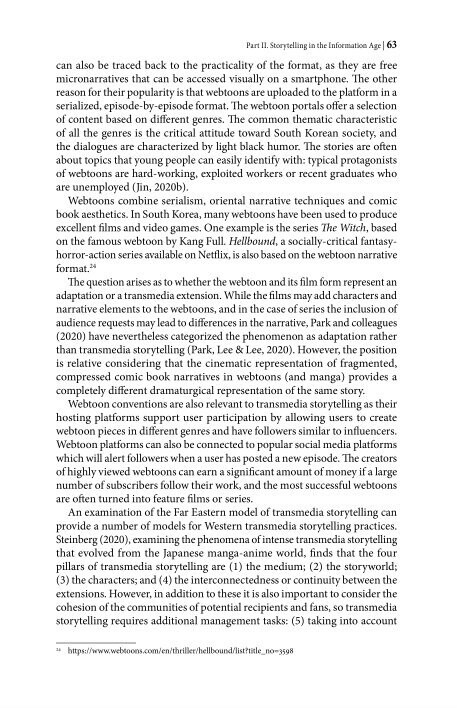
Page 64 [64]

OCR
Part II. Storytelling in the Information Age ] 63 can also be traced back to the practicality of the format, as they are free micronarratives that can be accessed visually on a smartphone. 1he other reason for their popularity is that webtoons are uploaded to the platform in a serialized, episode-by-episode format. Ihe webtoon portals offer a selection of content based on different genres. Ihe common thematic characteristic of all the genres is the critical attitude toward South Korean society, and the dialogues are characterized by light black humor. The stories are often about topics that young people can easily identify with: typical protagonists of webtoons are hard-working, exploited workers or recent graduates who are unemployed (Jin, 2020b). Webtoons combine serialism, oriental narrative technigues and comic book aesthetics. In South Korea, many webtoons have been used to produce excellent films and video games. One example is the series The Witch, based on the famous webtoon by Kang Full. Hellbound, a socially-critical fantasyhorror-action series available on Netflix, is also based on the webtoon narrative format." The guestion arises as to whether the webtoon and its film form represent an adaptation or a transmedia extension. While the films may add characters and narrative elements to the webtoons, and in the case of series the inclusion of audience reguests may lead to differences in the narrative, Park and colleagues (2020) have nevertheless categorized the phenomenon as adaptation rather than transmedia storytelling (Park, Lee & Lee, 2020). However, the position is relative considering that the cinematic representation of fragmented, compressed comic book narratives in webtoons (and manga) provides a completely different dramaturgical representation of the same story. Webtoon conventions are also relevant to transmedia storytelling as their hosting platforms support user participation by allowing users to create webtoon pieces in different genres and have followers similar to influencers. Webtoon platforms can also be connected to popular social media platforms which will alert followers when a user has posted a new episode. The creators of highly viewed webtoons can earn a significant amount of money if a large number of subscribers follow their work, and the most successful webtoons are often turned into feature films or series. An examination of the Far Eastern model of transmedia storytelling can provide a number of models for Western transmedia storytelling practices. Steinberg (2020), examining the phenomena of intense transmedia storytelling that evolved from the Japanese manga-anime world, finds that the four pillars of transmedia storytelling are (1) the medium; (2) the storyworld; (3) the characters; and (4) the interconnectedness or continuity between the extensions. However, in addition to these it is also important to consider the cohesion of the communities of potential recipients and fans, so transmedia storytelling requires additional management tasks: (5) taking into account 4 https://www.webtoons.com/en/thriller/hellbound/list?title_no=3598
structurelles
Custom
Image Metadata
- Largeur de l'image
- 1831 px
- Hauteur de l'image
- 2835 px
- Résolution de l'image
- 300 px/inch
- Taille du fichier d'origine
- 1.37 MB
- Lien permanent vers jpg
- 022_000040/0063.jpg
- Lien permanent vers OCR
- 022_000040/0063.ocr
